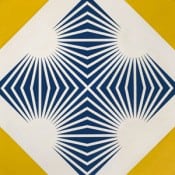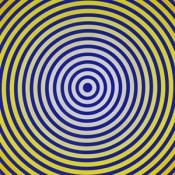Explore
![]()
Bill Komodore
(American, born in Greece, 1932-2012)
Himeropa, 1965
acrylic on canvas, 64 1/2 x 64 3/4 inches
Artwork courtesy the Estate of Bill Komodore
Born in Athens in 1932, Bill Komodore emigrated to the United States in 1947 and later studied art at Tulane University in New Orleans. A keen observer of nature, he became fascinated by peculiar visual phenomena, such as after-images, triggered by certain geometric patterns. In the 1960s he embarked on a radical approach to abstraction that exploited the potential of these elusive optical effects. Characterized by minimal compositional structures, such as repeating squares or parallel lines, Komodore’s paintings generate powerful perceptual anomalies. As the artist has noted, these uncomfortable effects reflect his anxiety about the uncertain state of the world at the time.
Himeropa is named after one of the sirens of Greek mythology who seduced seafarers to their tragic end, an apt metaphor for the visual attraction and distress elicited by the painting. With compelling works such as this Komodore became a leading figure in the widespread movement of perceptual art, commonly known as Op Art, that flourished in the mid-1960s. Himeropa was included in a national traveling exhibition of this new tendency organized by the Museum of Modern Art in 1966. It remained in the artist’s personal collection until his death in 2012.
My large creative output has not been the mere application of “new” concepts (flicker, vibration, after-image) but has resulted from the realization that the expression involved is the only one suitable to the way I feel about the world and about art.
Other Works by Bill Komodore
No related posts found




